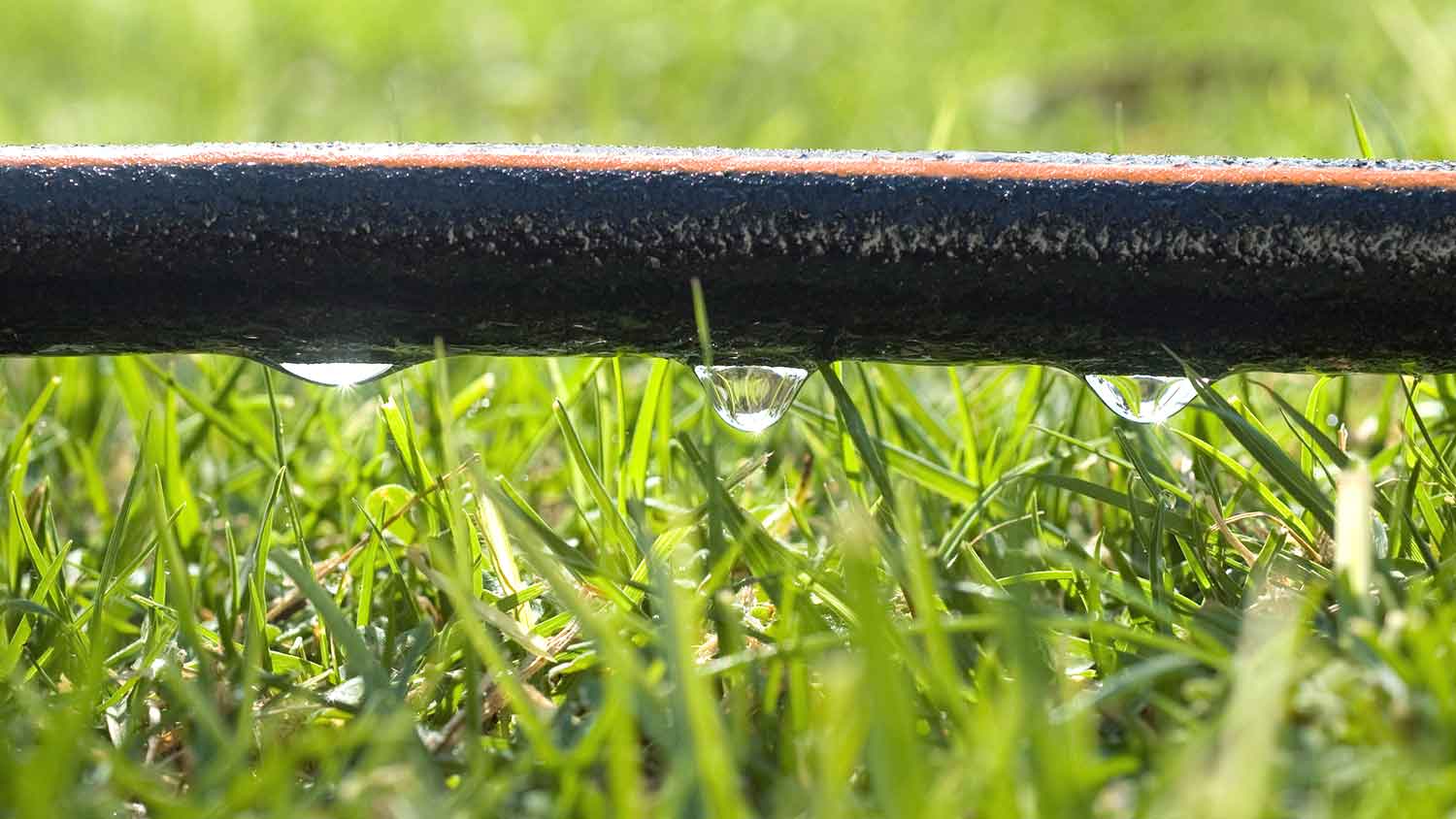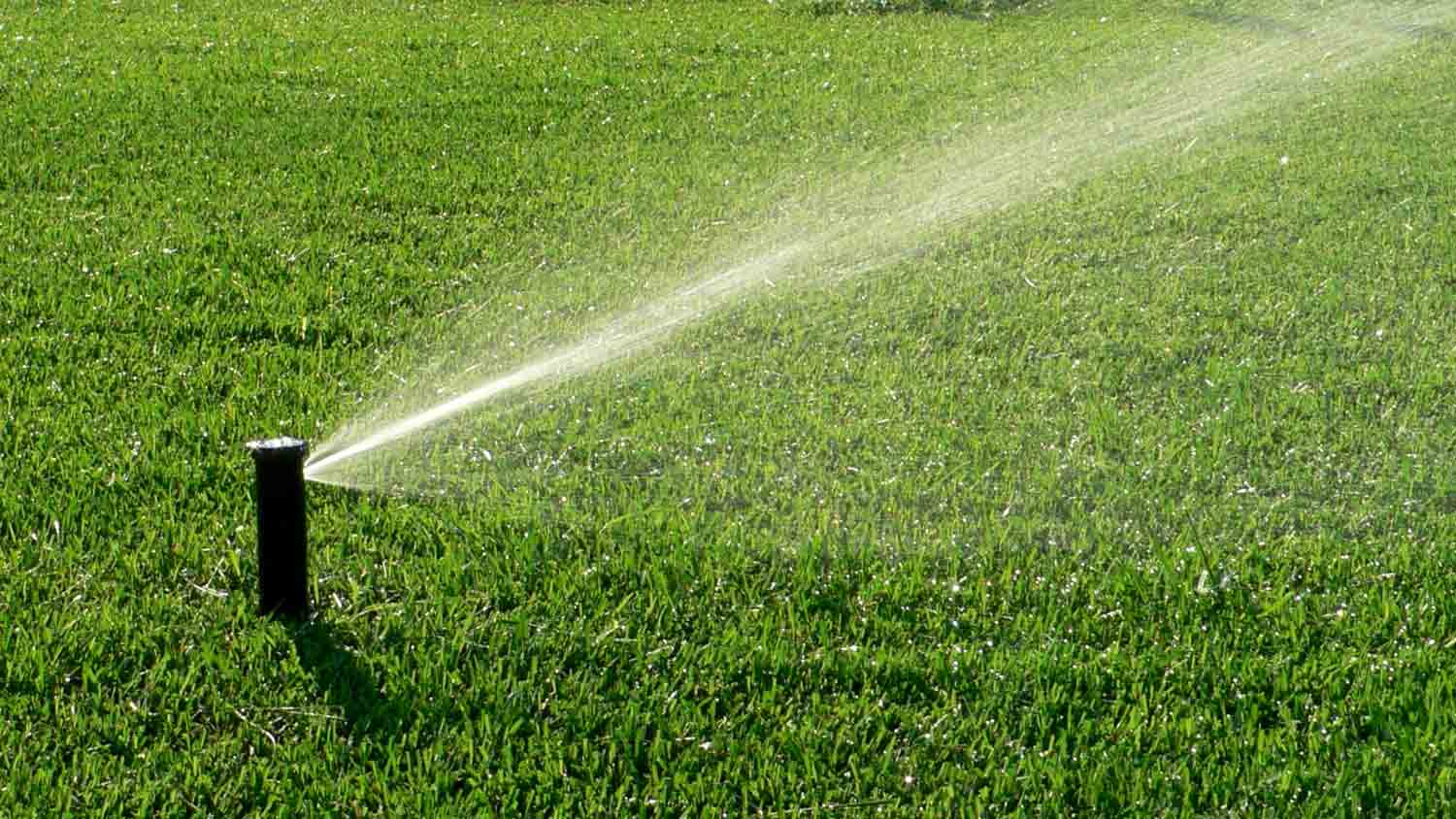
Discover drip irrigation system cost estimates, key price factors, and ways to save. Get transparent pricing to plan your home irrigation project confidently.
No sprinklers, no problems


Drip irrigation systems and soaker hoses are your main options for going sprinkler-free.
Installing a drip irrigation system in your typical suburban quarter-acre lawn costs $450 to $600, while a soaker hose costs about $22 per unit.
Drip systems need to be winterized, but soaker hoses don’t require replacement parts and winterization like traditional sprinkler systems.
Going sprinkler-free saves over 35,000 gallons of water per year, slashing your water bills dramatically.
Automatic sprinkler systems have long been the standard for irrigating lawns so they'll always be a lush emerald carpet. But with water conservation and rising utility prices becoming major concerns among homeowners, many want to know the best way to water your lawn without a sprinkler system. Whether you want to replace your traditional irrigation system or haven't installed any sprinklers yet, we'll walk you through alternatives that are just as effective, even if you have a large lawn.
Traditional sprinkler systems are relatively inexpensive to install and maintain, but what makes them so costly is the huge water bills they create in the long run. While sprinklers are inexpensive upfront, they consume a lot of resources and aren't as efficient as alternative irrigation systems because so much water is lost to evaporation. With how much you pay to run the sprinklers just for it to be lost through evaporation, it's as cost-effective as ordering fee-heavy food delivery for every meal.
Here are some alternative irrigation systems to consider in place of traditional sprinklers.
Drip systems connect the roots of plants with tubes or hoses so that water can be sent directly to them, 5-star hotel concierge style. While extremely efficient for watering plants so that they stay lush and healthy, including grass, drip systems aren't tenable for large lawns unless they work in conjunction with tripod sprinklers that can spread over larger areas. Subsequently, drip systems are more popular for gardens and small lawns.
In comparison, drip irrigation systems cost $0.50 to $3 per square foot depending on the type of surface. Most homeowners use drip systems for smaller irrigation projects, like vegetable gardens. If you're irrigating a lawn, it will have a higher cost per square foot for underground installation. A quarter-acre lawn costs about $450 to $600 to install. For large lawns, installing a drip irrigation system in a two-acre lawn would cost $3,600 to $5,000.
While the upfront costs of a drip irrigation system can seem lower than sprinklers, it may be significantly more expensive depending on the complexity of your climate, soil, lawn size, and other factors.
A local sprinkler installation service can give you a more accurate estimate, but keep in mind that hiring a pro will cost more than DIY. Installing a drip system yourself is doable with the right tools and equipment. But if you're not comfortable digging trenches and installing PVC pipes, it's best left to the professionals.

When it comes to water conservation and overall efficacy, soaker hoses are the ultimate "set it and forget it" type of irrigation while being far more efficient than sprinklers. Soaker hoses bear a closer resemblance to bungee cords than your typical garden hose, with holes poked in it like a flute. The hose is laid on the ground, and the water seeps out of those holes, continuously soaking your lawn like a slow-brewed lawn tea.
Soaker hoses are incredibly flexible, but they have a maximum working length of 200 feet. You can have a longer soaker hose setup, but the water flow won't be as strong. Another drawback of soaker hoses is that they can’t be used on slopes, so you’d need to explore other options if your lawn sits on a hill.
Soaker hoses are a very budget-friendly DIY option suitable for all skill levels. A 100-foot soaker hose costs about $22 per unit and doesn't require professional assistance to install.
Finding the right time to seed your lawn gives you optimal rainfall for free. But if you seed your lawn at the wrong time of year, summer heat could strike and completely dehydrate the soil. Cold weather also doesn't foster grass growth because grass seeds need certain temperatures to germinate.
The best time of year for reseeding your lawn depends on where you live. Cold-season grasses like fescues encompass most of the grass in North America while the southern United States has warm-season grass like carpetgrass. Homeowners in the transition zone that spans the southern west coast through the Carolinas have both warm-season and cool-season grasses. The type of grass you have dictates when you should seed it, and deciduous climates like the Northeast can make it difficult to determine. Climate change is only exacerbating this effect as typical weather patterns get subverted and harder to predict.
In order to literally align your irrigation needs with the stars, pay close attention to local weather forecasts on a weekly basis.

A little elbow grease goes a long way, and lawns don’t always need to be watered daily. While a hose or watering can be impractical for a lawn exceeding half an acre (lugging them around doesn’t sound fun), if you feel like getting some sun and exercise, it doesn’t hurt to channel your inner farmer and manually water your lawn as needed. Plus, you’ll be able to bring the watering can or hose to those hard-to-reach areas where sprinklers can’t go.
The best time to water grass is at dawn or early evening before the sun is fully out. This will result in less wasted water from evaporation.
There are many benefits to watering your lawn without a sprinkler system, including water conservation and money savings. Let’s dive into the benefits.
Irrigation systems are incredibly convenient. Otherwise, homeowners wouldn't pay to install and maintain them. But according to the US Environmental Protection Agency, the average American household uses 320 gallons of water per day, or 9,600 gallons per month, with 30% of that devoted to outdoor irrigation. By these calculations, the average American household uses over 35,000 gallons of water per year on irrigation alone.
Going sprinkler-free reduces strain on your local water supply if you live in an area where it is limited.
There are several different methods that your township, county, or city might use to set your water bill, which the Environmental Protection Agency explains. Many local governments use an increasing block rate to discourage excessive water usage, where users are charged more per gallon once they cross a certain threshold. This is particularly common in large cities and areas with water shortages, such as California and other desert states.
Eliminating your sprinklers can bring your water usage down to a tier where you’ll pay a lower rate. Using the average American household water use baseline of 9,600 gallons per month, if we reduce it by 30% to 6,720 gallons, it’ll result in a lower water bill across the board. But it’s especially palpable in areas that use the increasing block rate to bill residents for water.
This equates to hundreds or even thousands of dollars saved on utilities that you can now put towards rainy day savings, home improvements, or the little pleasures in life.
Drip irrigation systems require maintenance and damaged parts will periodically need replacement. They also need to be winterized during the colder months because they have pipes that can burst if frozen with water still inside.
But if you opt for soaker hoses or completely scrap irrigation systems altogether in favor of natural seed planning or manual watering, there’s no winterization to worry about. There are no replacement sprinkler heads or parts to buy. This saves not only money but also a lot of mental energy.
From average costs to expert advice, get all the answers you need to get your job done.

Discover drip irrigation system cost estimates, key price factors, and ways to save. Get transparent pricing to plan your home irrigation project confidently.

Discover the average outdoor misting system cost, key price factors, and ways to save. Get transparent, expert-backed estimates for your installation.

Discover the cost to winterize a sprinkler system, including average prices, key cost factors, and tips to save. Learn what impacts your estimate and how to budget.

Lawn irrigation system issues can be frustrating, especially if it’s running up your water bills. Here are seven sprinkler problems to troubleshoot.

Wondering how to find irrigation valves on your property? Locating them can be challenging. Learn how to tackle this project with our guide.

Our guide on how to add a sprinkler head outlines all of the steps involved in the process and answers some of the more common questions relating to installation.